CHEVROLET EXPRESS 1996 1.G Owners Manual
Manufacturer: CHEVROLET, Model Year: 1996, Model line: EXPRESS, Model: CHEVROLET EXPRESS 1996 1.GPages: 376, PDF Size: 18.83 MB
Page 221 of 376
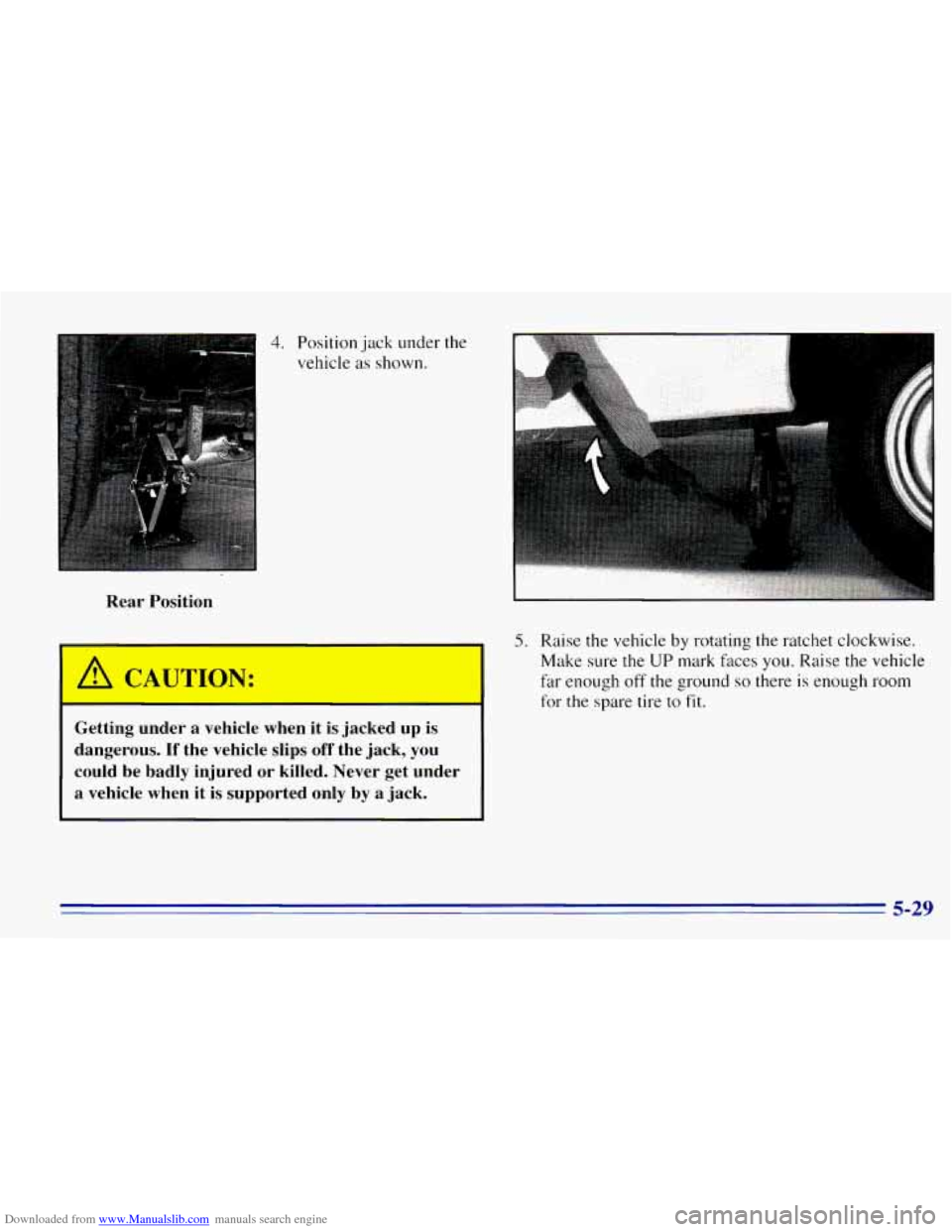
Downloaded from www.Manualslib.com manuals search engine 4. Position jack under the
vehicle as shown.
Rear Position
A C A UTION:
Getting under a vehicle when it is jacked up is
dangerous.
If the vehicle slips off the jack, you
could be badly injured or killed. Never get under
a vehicle when it is supported only by a jack.
5. Raise the vehicle by rotating the ratchet clockwise.
Make sure
the UP mark faces you. Raise the vehicle
hr enough off the ground so there is enough room
for the spare tire to fit.
5-29
Page 222 of 376
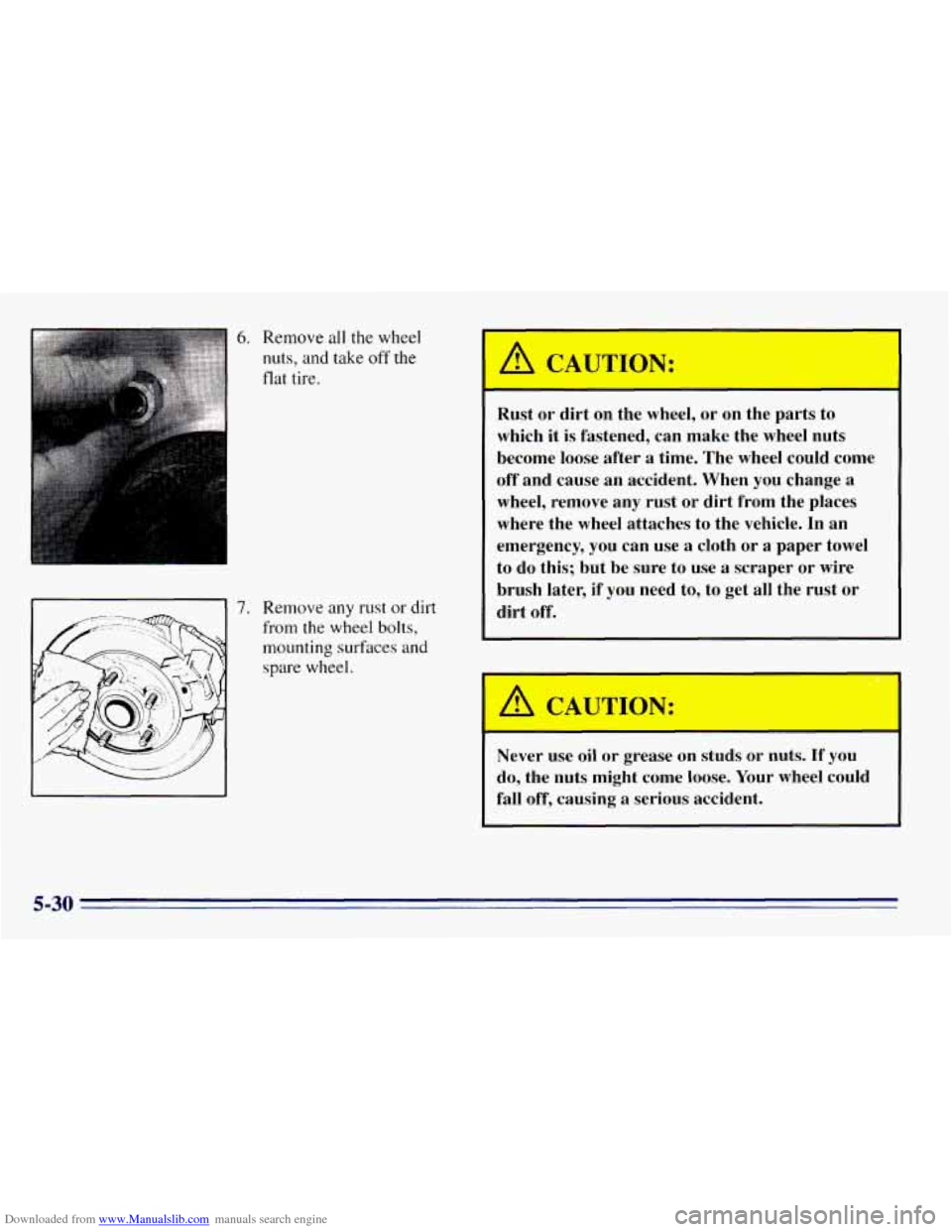
Downloaded from www.Manualslib.com manuals search engine 6. Remove all the wheel
nuts,
and take off the
flat tire.
7. Remove any rust or dirt
from the
wheel bolts,
mounting surfaces and
spare wheel.
A CAUTION:
Rust or dirt on the wheel, or on the parts to
which
it is fastened, can make the wheel nuts
become loose after a time. The wheel could come
off and cause an accident. When you change a
wheel, remove any rust or dirt from the places
where the wheel attaches to the vehicle. In an
emergency, you can use a cloth
or a paper towel
to do this; but be
sure to use a scraper or wire
brush later,
if you need to, to get all the rust or
dirt off.
I A CAUTION:
Never use oil or grease on studs or nuts. If you
do, the nuts might come loose. Your wheel could
fall off, causing
a serious accident.
I I
5-30
Page 223 of 376
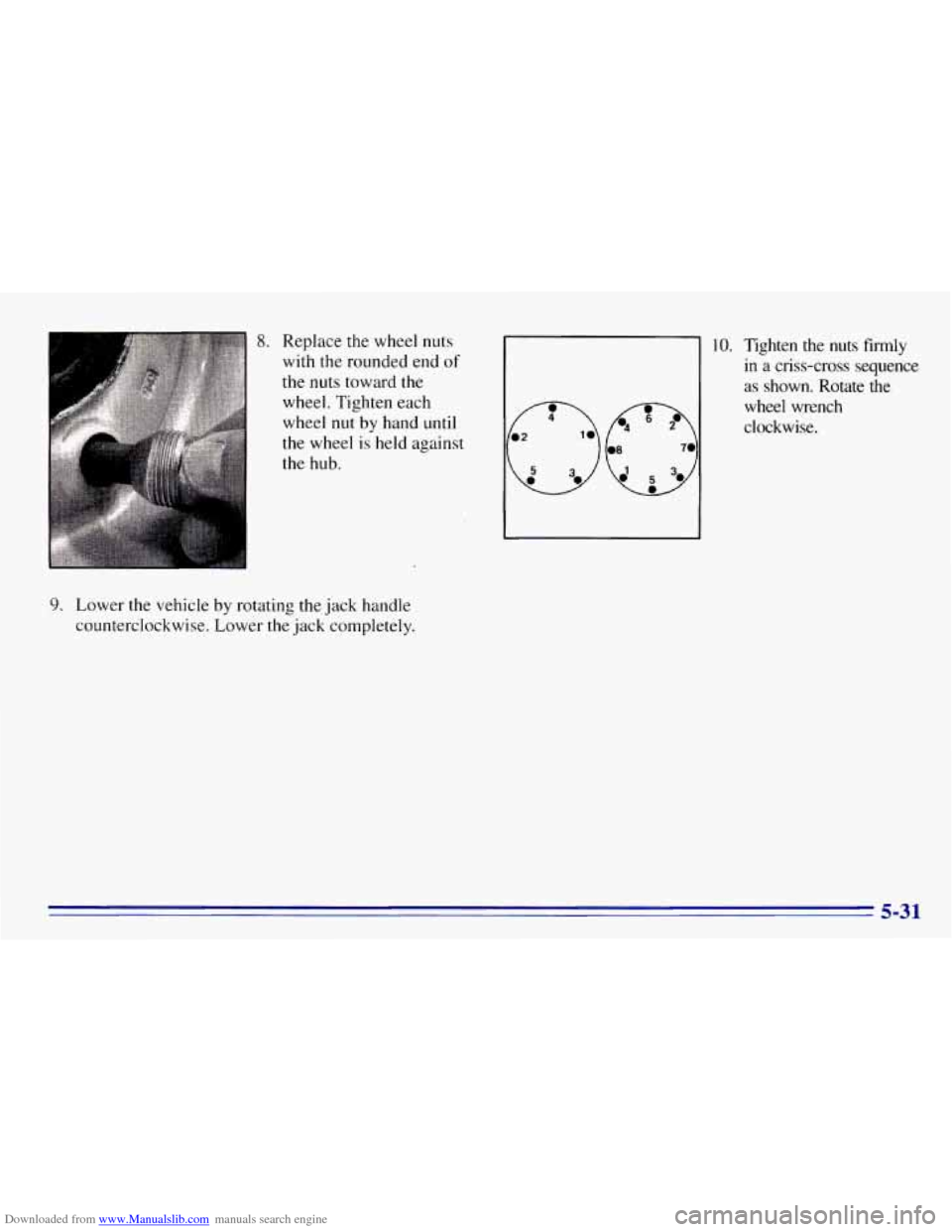
Downloaded from www.Manualslib.com manuals search engine 8. Replace the wheel nuts
with the rounded end
of
the nuts toward the
wheel. Tighten each
wheel
nut by hand until
the wheel
is held against
the hub.
9. Lower the vehicle by rotating the jack handle
counterclockwise. Lower
the jack completely.
10. Tighten the nuts firmly
in a criss-cross sequence
as shown. Rotate the
wheel wrench
clockwise.
5-31
Page 224 of 376
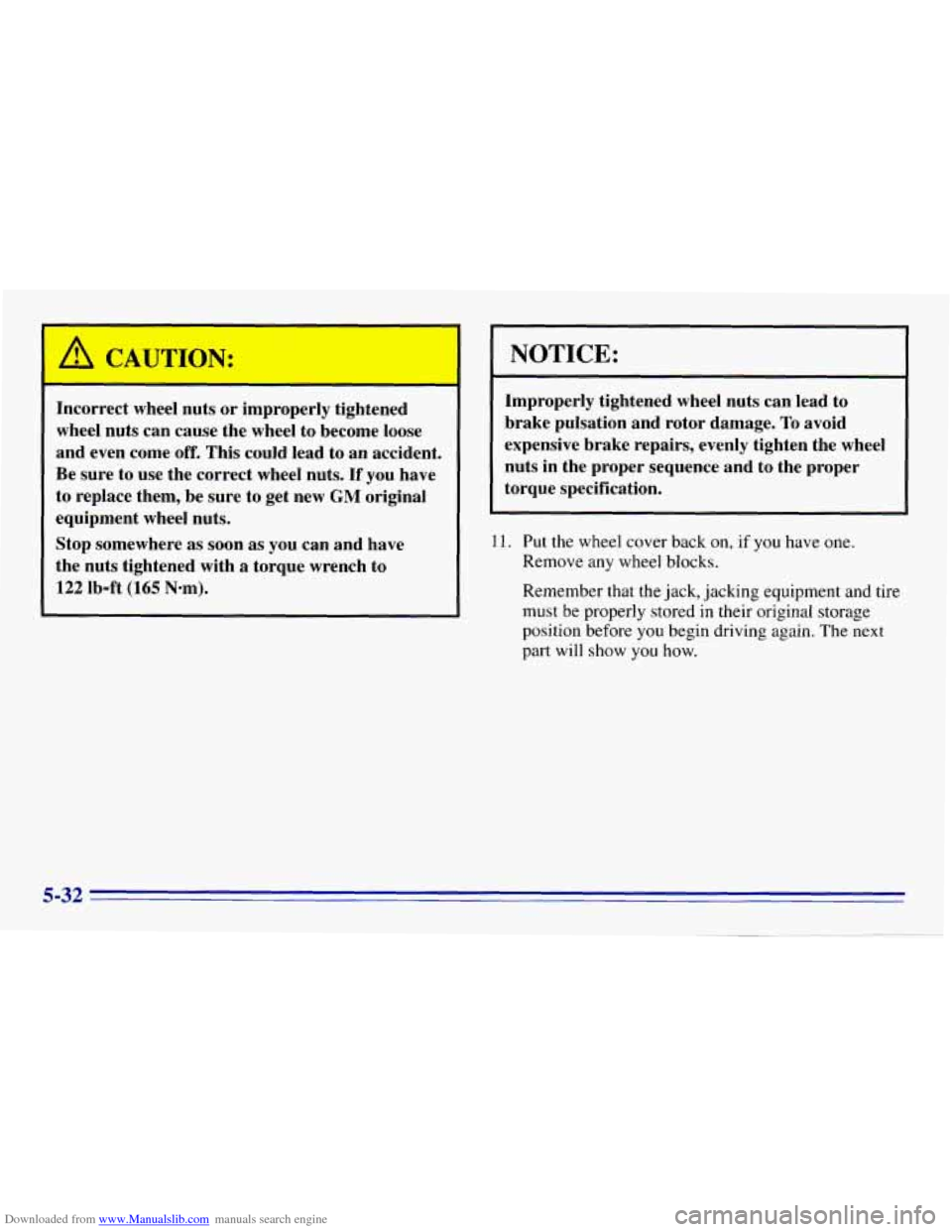
Downloaded from www.Manualslib.com manuals search engine A CAUTION:
Incorrect wheel nuts or improperly tightened
wheel nuts can cause the wheel to become loose
and even come
off. This could lead to an accident.
Be sure to use the correct wheel nuts. If you have
to replace them, be sure to get new
GM original
equipment wheel nuts.
Stop somewhere as soon as you can and have
the nuts tightened with
a torque wrench to
122 lb-ft (165 Nom).
NOTICE:
Improperly tightened wheel nuts can lead to
brake pulsation and rotor damage.
To avoid
expensive brake repairs, evenly tighten the wheel
nuts in the proper sequence and to the proper
torque specification.
11. Put the wheel cover back on, if you have one.
Remove any wheel blocks.
Remember that the jack, jacking equipment and tire
must be properly stored in their original storage
position before
you begin driving again. The next
part will show you how.
5-32
Page 225 of 376
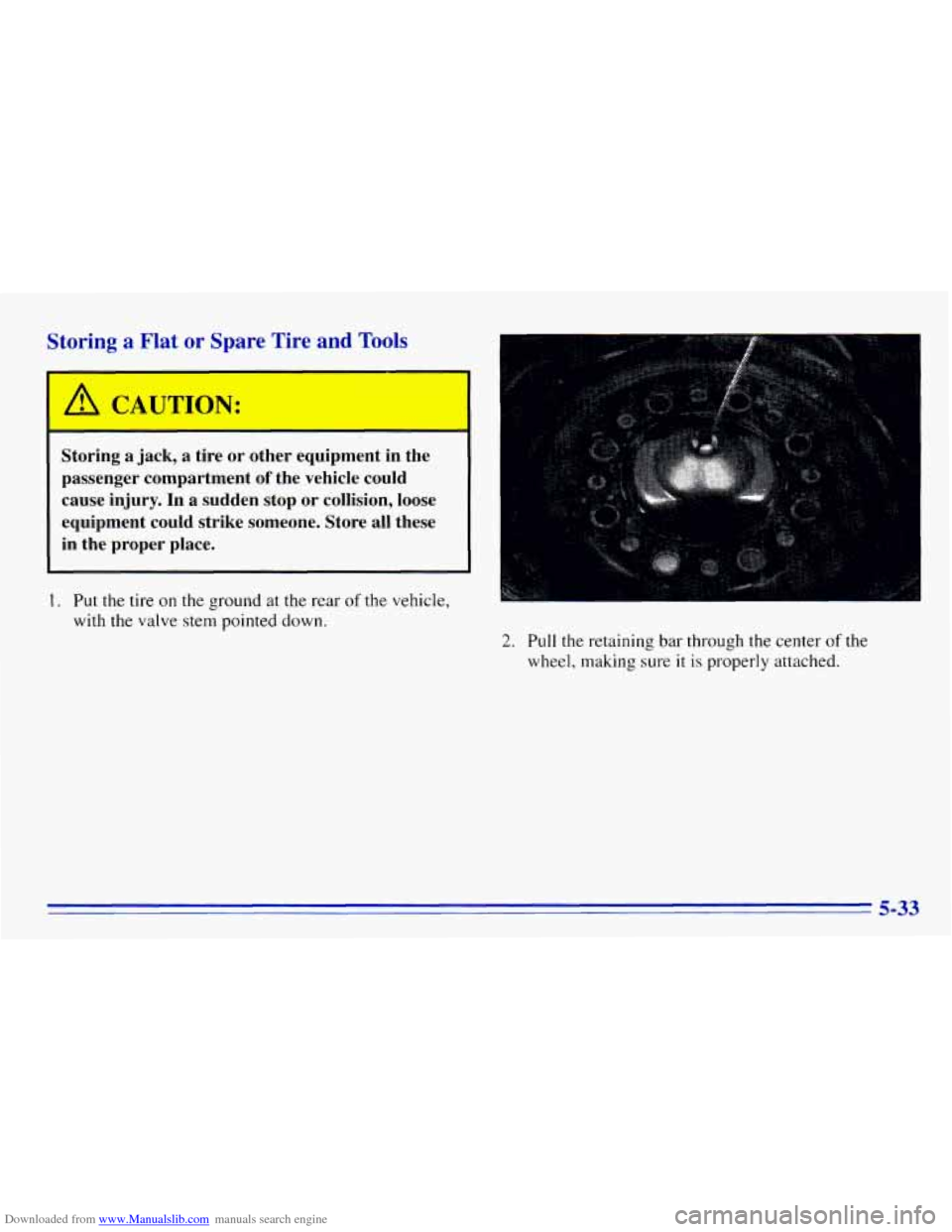
Downloaded from www.Manualslib.com manuals search engine Storing a Flat or Spare Tire and Tools
Storing a jack, a tire or other equipment in the
passenger compartment
of the vehicle could
cause injury. In a sudden stop
or collision, loose
equipment could strike someone. Store
all these
in the proper place.
I. Put the tire on the ground at the rear of the vehicle,
with the valve stem pointed down.
2. Pull the retaining bar through the center of the
wheel, making sure it
is properly attached.
5-33
Page 226 of 376
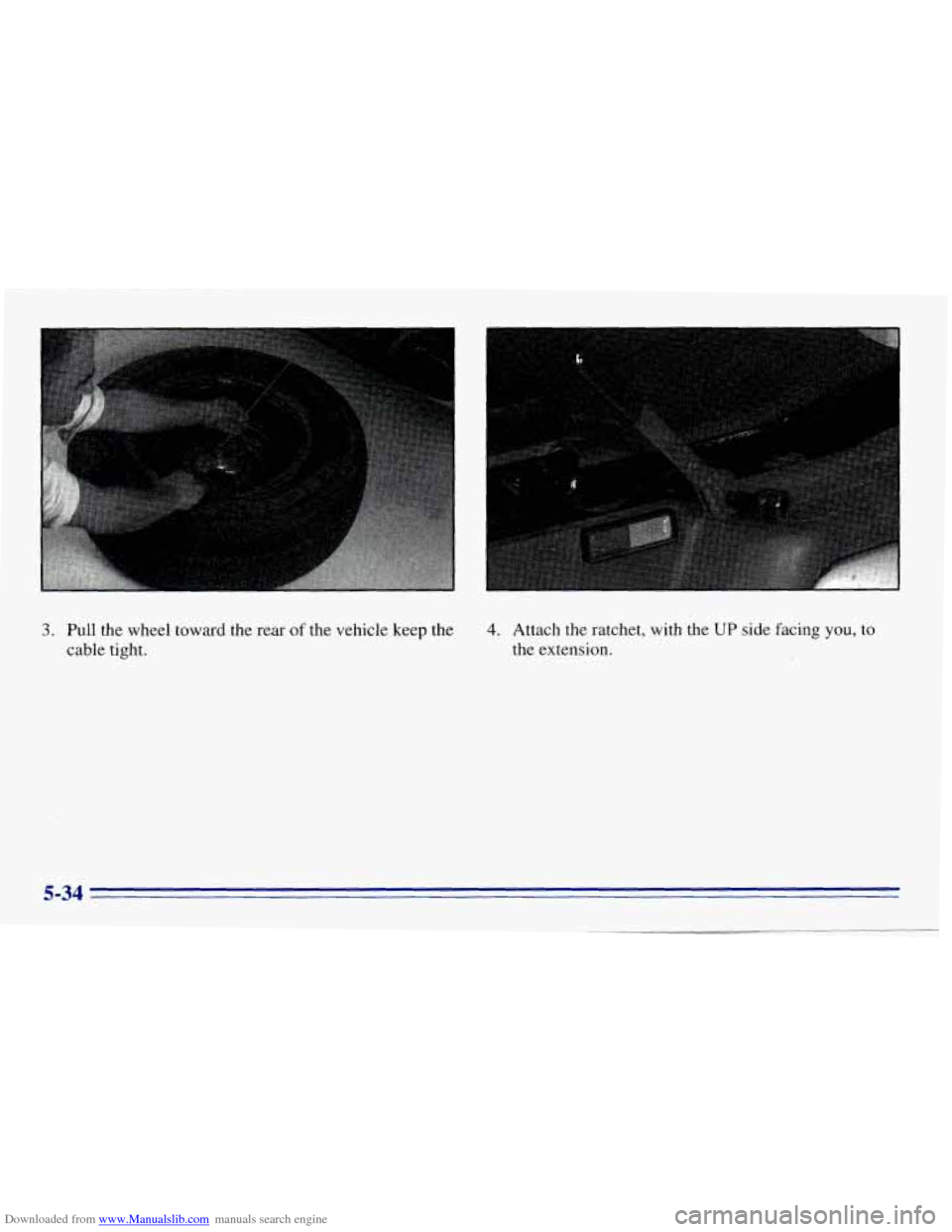
Downloaded from www.Manualslib.com manuals search engine 3. Pull the wheel toward the rear of the vehicle keep the
cable tight. 4. Attach the ratchet, with the UP side facing you, to
the extension.
5-34
Page 227 of 376
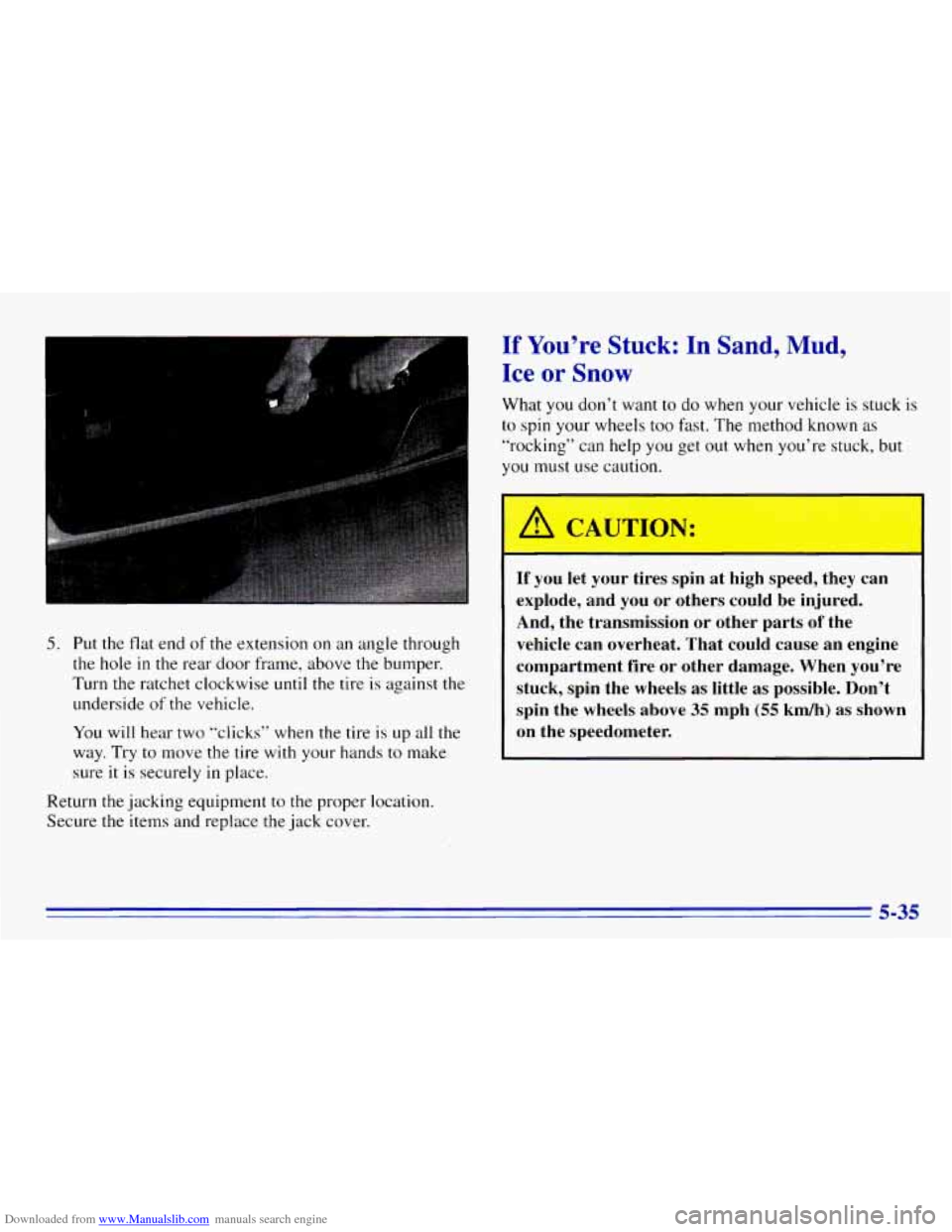
Downloaded from www.Manualslib.com manuals search engine 5. Put the flat end of the extension on an angle through
the
hole in the rear door frame, above the bumper.
Turn the ratchet clockwise until the tire is against the
underside
of the vehicle.
You will hear two “clicks”
when the tire is up all the
way. Try
to move the tire with your hands to make
sure
it is securely in place.
Return the jacking equipment to the proper location.
Secure the items and replace the jack cover.
If You’re Stuck: In Sand, Mud,
Ice or Snow
What you don’t want to do when your vehicle is stuck is
to spin your wheels too fast. The method known as
“rocking’’ can help you get out when you’re stuck, but
you must use caution.
If you let your tires spin at high speed, they can
explode, and you or others could be injured.
And, the transmission or other parts
of the
vehicle can overheat. That
could cause an engine
compartment fire or other damage. When you’re
stuck, spin the wheels
as little as possible. Don’t
spin the wheels above
35 mph (55 km/h) as shown
on the speedometer.
L 2t
Page 228 of 376
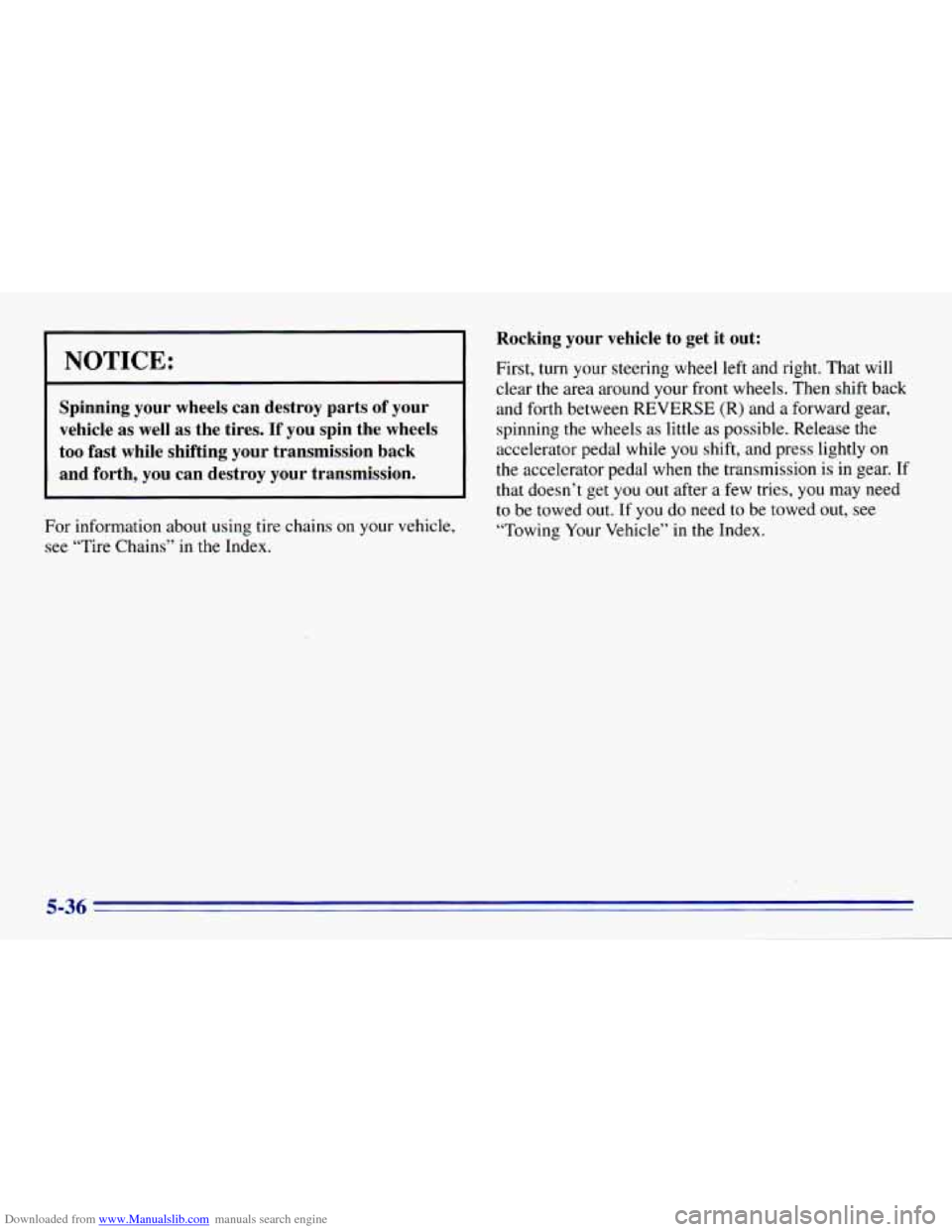
Downloaded from www.Manualslib.com manuals search engine I NOTICE:
Spinning your wheels can destroy parts of your vehicle as well as the tires. If you spin the wheels
too fast while shifting your transmission back
and forth, you can destroy your transmission.
~ ~ ~~
For information about using tire chains on your vehicle,
see “Tire Chains” in the Index.
Rocking your vehicle to get it out:
First, turn your steering wheel left and right. That will
clear the area around your front wheels. Then shift back
and forth between REVERSE (R) and
a forward gear,
spinning the wheels as little as possible. Release
the
accelerator pedal while you shift, and press lightly on
the accelerator pedal when the transmission is in gear. If
that doesn’t get
you out after a few tries, you may need
to be towed out. If you do need to be towed out, see
“Towing Your Vehicle”
in the Index.
5-36
Page 229 of 376
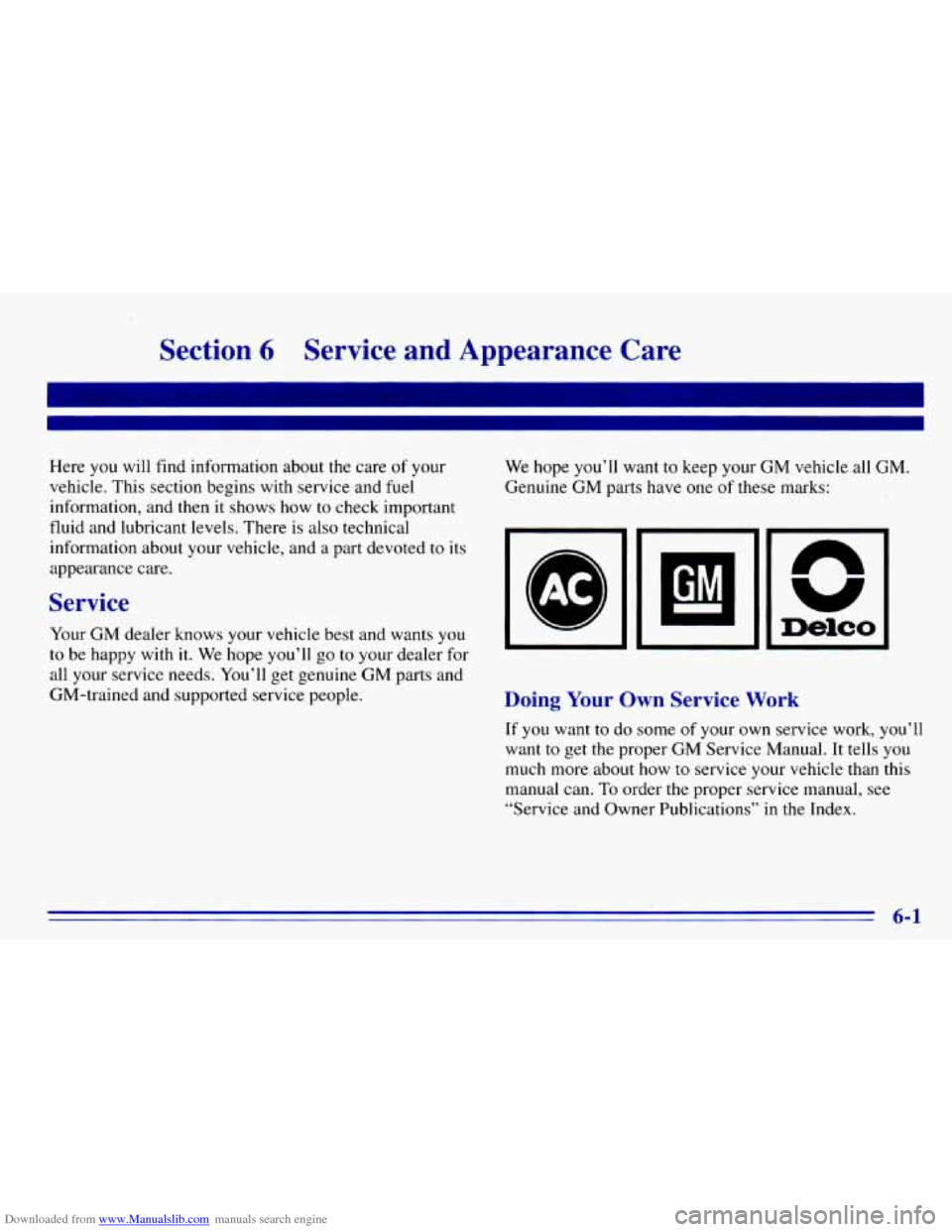
Downloaded from www.Manualslib.com manuals search engine Section 6 Service and Appearance Care
Here you will find information about the care of your
vehicle. This section begins with service and fuel
information, and then it shows how to check important
fluid and lubricant levels. There is also technical
information about your vehicle, and a part devoted to its
appearance care.
Service
Your GM dealer knows your vehicle best and wants you
to be happy with it. We hope you’ll go to your dealer for
all your service needs. You’ll get genuine
GM parts and
GM-trained and supported service people. We
hope you’ll want to keep your GM vehicle all GM.
Genuine GM parts have
one of these marks:
Doing Your Own Service Work
If you want to do some of your own service work, you’ll
want
to get the proper GM Service Manual. It tells you
much more about how to service your vehicle than this
manual can.
To order the proper service manual, see
“Service and Owner Publications’’ in the Index.
Page 230 of 376
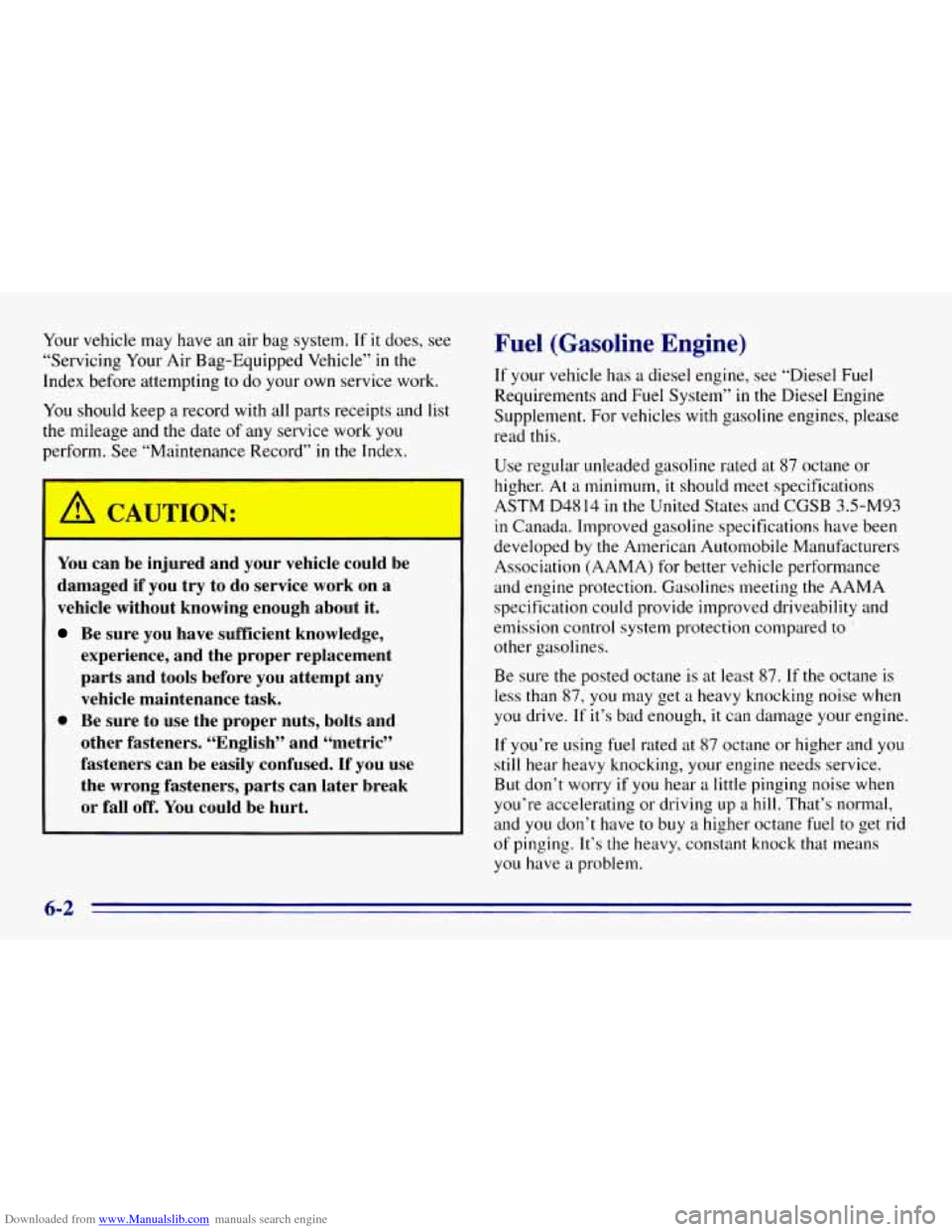
Downloaded from www.Manualslib.com manuals search engine Your vehicle may have an air bag system. If it does, see
“Servicing Your Air Bag-Equipped Vehicle”
in the
Index before attempting to do your own service work.
You should keep a record with all parts receipts and list
the mileage and the date of any service work
you
perform. See “Maintenance Record” in the Index.
You can be injured and your vehicle could be
damaged if you try to do service work on a
vehicle without knowing enough about it.
Be sure you have sufficient knowledge,
experience, and the proper replacement
parts and tools before you attempt any vehicle maintenance task.
0 Be sure to use the proper nuts, bolts and
other fasteners. “English” and “metric”
fasteners can be easily confused. If
you use
the wrong fasteners, parts can later break
or fall off. You could be hurt.
Fuel (Gasoline Engine)
If your vehicle has a diesel engine, see “Diesel Fuel
Requirements and Fuel System”
in the Diesel Engine
Supplement. For vehicles with gasoline engines, please
read this.
Use regular unleaded gasoline rated at
87 octane or
higher.
At a minimum, it should meet specifications
ASTM D48 14 in the United States and CGSB 3.5-M93
in Canada. Improved gasoline specifications have been
developed by the American Automobile Manufacturers
Association (AAMA) for better vehicle performance
and engine protection. Gasolines meeting the AAMA
specification could provide improved driveability and
emission control system protection compared to
other gasolines.
Be sure the posted octane is at least
87. If the octane is
less than
87, you may get a heavy knocking noise when
you drive.
If it’s bad enough, it can damage your engine.
If you’re using fuel rated at 87 octane or higher and you
still hear heavy knocking, your engine needs service.
But don’t worry if you hear a little pinging noise when
you’re accelerating or driving
up a hill. That’s normal,
and
you don’t have to buy a higher octane fuel to get rid
ofpinging.
It’s the heavy, constant knock that means
you have a problem.
6-2